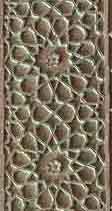REQUIRED
WORK:
*Ikram,
Chapter 10: The
Establishment of the Mughal Empire, pp. 135-42
*Ikram,
Chapter 11: The
Age of Akbar, pp. 143-55
*Ikram,
Chapter 12: Religion
at Akbar's Court, pp. 156-65
*Ikram,
Chapter 13: The
Orthodox Reaction, pp. 166-74
Online through
CU as
a "Virtual
Reading Room Text." Another source: the
public version.
*Eaton, "The
Rise
of Mughal Power," Chapter 6 (pp. 137-158) of Richard M. Eaton, The
Rise of Islam and the Bengal Frontier, 1204-1760. Berkeley: Univ.
of
California Press, 1993. BUTLER RESERVE. Also: online
at UC Press. also: online
through NetLibrary. Within their system, here is the exact
location.
*Muzaffar
Alam, The Sufi Intervention,
pp. 81-114, of The Languages of
Political Islam: India 1200-1800. New Delhi: Permanent Black,
2004. At Book Culture; also on BUTLER RESERVE.
*"The
Conquest of
Malwa" and related matters, excerpts from chapters 33-39 (drawn
from
pp. 207-244) of Volume 2 of The Akbar-nama of Abu'l-fazl; history
of
the reign of Akbar, including an account of his predecessors (3
vols.),
trans. by Henry Beveridge: these
excerpts (Chs. 33-39) on the CU website.
POSSIBLE
PAPER TOPIC THREE:
A second part of
Abu'l-Fazl's great
work consists of three more volumes called the A'in-e Akbari,
the
"Institutes of Akbar." These remarkable volumes contain a detailed
account
of the world as Abu'l-Fazl knew it, and the royal court as Akbar
organized
it-- take a look at the Table
of Contents. At the very end of the third volume appears a collection
of Akbar's sayings. This collection, carefully compiled over the
years
by his chosen companion and biographer, is as close as we are ever
likely
to get to Akbar's own view of the world. Into what categories would you
divide these sayings? Do you find them internally coherent? Using only
these sayings, see if you can create a map of Akbar's mind, and reach
some
conclusions about his basic philosophical views.



